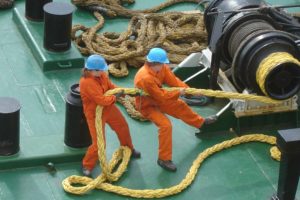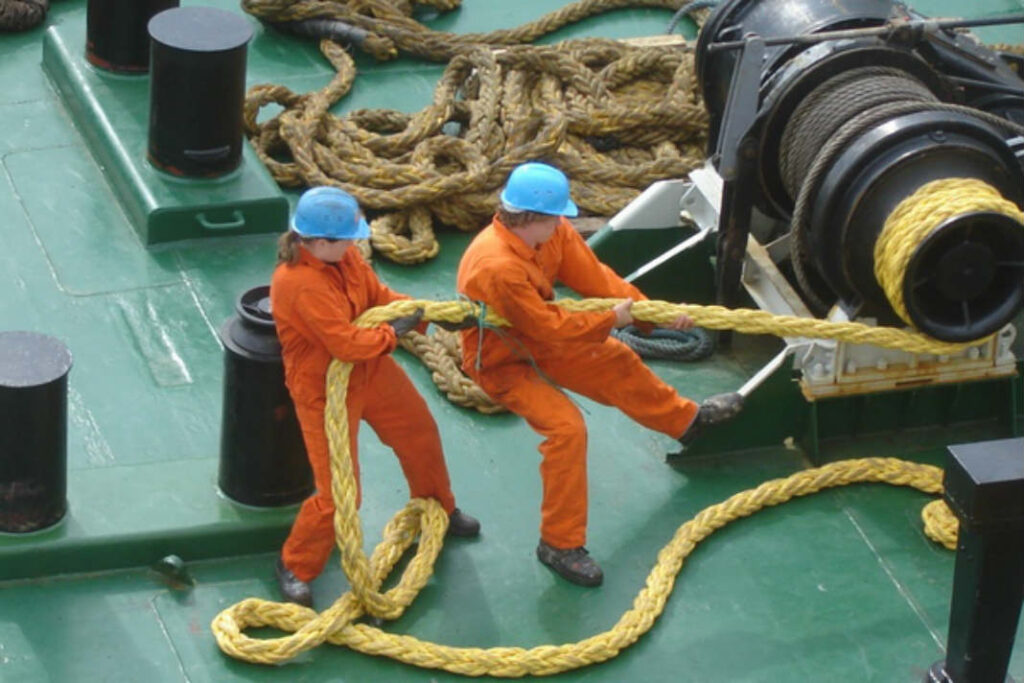The maritime industry is a complex and demanding field, where safety, efficiency, and reliability are paramount. At the heart of a ship’s operation lies the deck department, a vital component responsible for the safe navigation of the vessel and the proper handling of cargo. This department ensures that the ship not only reaches its destination but also does so safely and efficiently, with its cargo intact and the vessel in optimal condition. While the focus often falls on the officers who command and make critical decisions, the importance of the deck department’s ratings—the crew members who are not officers—cannot be overstated.
These ratings form the backbone of the deck department, executing a broad spectrum of tasks that are essential to the ship’s daily operations. Their work often goes unnoticed by the outside world, yet it is their hands-on efforts that maintain the ship’s integrity and ensure the smooth flow of operations from port to port. Whether it’s managing the rigging, steering the ship, maintaining the decks, or ensuring the proper mooring of the vessel, these crew members are indispensable.
The Critical Role of the Deck Department Ratings
The deck department on a ship is primarily responsible for navigation, cargo operations, maintenance, and ensuring the overall safety of the vessel. This department is divided into two main categories: the officers, who are in command and make strategic decisions, and the ratings, who perform the operational tasks that keep the ship functioning effectively.
While officers are tasked with planning voyages, navigating through potentially treacherous waters, and making high-level decisions, the ratings are the ones who physically implement these plans. They ensure that the ship’s exterior remains seaworthy, that the cargo is properly loaded, secured, and unloaded, and that safety protocols are followed to the letter. The collaboration between officers and ratings is crucial—each depends on the other to fulfill the ship’s mission.
Deck department ratings are the unsung heroes of maritime operations. Without them, the officers’ plans and strategies would remain just that—plans and strategies. It is the ratings who bring these plans to life, handling the day-to-day tasks that ensure the ship runs smoothly.
From the moment a ship leaves port until it arrives at its destination, ratings are involved in almost every aspect of its operation. They handle the physical demands of seamanship, from steering the ship to maintaining the decks, managing the rigging, and even participating in emergency procedures. Their roles require a deep understanding of ship operations, physical strength, endurance, and an unwavering commitment to safety.
The Hierarchical Structure of Deck Department Ratings
The deck department ratings are organized into a well-defined hierarchy, each level with its own set of responsibilities and duties. This hierarchical structure ensures that there is a clear chain of command, which is essential for maintaining order and efficiency on board.
- Bosun (Boatswain): The highest-ranking rating in the deck department, the Bosun acts as the foreman of the deck crew. This role involves supervising the other ratings, coordinating their activities, and ensuring that all deck operations are carried out safely and efficiently.
- Able Seaman (AB): The Able Seaman is an experienced and skilled deckhand who performs a wide range of tasks. They are the most versatile of the ratings, capable of handling everything from steering the ship to performing complex maintenance tasks.
- Ordinary Seaman (OS): The Ordinary Seaman is typically an entry-level position, where individuals gain the basic skills and experience necessary to advance in their maritime careers. They assist the more experienced crew members and learn the ropes of deck work.
- Deck Cadet or Trainee: Although not technically a rating, the Deck Cadet or Trainee is an individual in training to become a deck officer. They perform many of the same duties as ratings, while also learning the skills necessary to take on a command role in the future.
- Deck Utility or Wiper: This is a more generalized role that involves performing tasks across various departments. While their duties often overlap with those of the deck ratings, they may also assist in other areas of the ship as needed.

The Ranks and Roles of Deck Department Ratings
Each of these roles has distinct responsibilities and is crucial to the overall functioning of the deck department:
Bosun (Boatswain):The Bosun is the senior-most rating in the deck department. Often referred to as the foreman of the deck crew, the Bosun acts as the direct supervisor of the other deck ratings.
Key Duties:
- Supervising and coordinating the work of the deck crew.
- Maintenance of the ship’s hull, decks, and superstructure.
- Overseeing the rigging of ropes, cables, and other equipment.
- Supervising the loading and unloading of cargo.
- Managing the storage and upkeep of deck equipment and tools.
- Assisting in mooring and anchoring operations.
Skills and Certifications Required:
- Typically requires certification as an Able Seaman (AB) with several years of experience.
- Proficiency in leadership and maritime operations.
- Certificates in basic safety training, first aid, fire-fighting, and proficiency in survival craft and rescue boats.
Able Seaman (AB): The Able Seaman (AB) is an experienced deckhand with a broad skill set. The AB performs a wide range of tasks under the direction of the Bosun or Deck Officers.
Key Duties:
- Steering the ship during watches.
- Performing maintenance tasks, such as painting and cleaning the ship.
- Handling mooring lines and anchoring equipment.
- Operating deck machinery, such as winches and windlasses.
- Assisting in cargo operations.
- Participating in emergency drills and safety operations.
Skills and Certifications Required:
- STCW (Standards of Training, Certification, and Watchkeeping) certification as an Able Seaman.
- Basic safety training, proficiency in survival craft, and security awareness.
- Experience in deck operations and seamanship.
Ordinary Seaman (OS): The Ordinary Seaman is the entry-level position for deck ratings. The OS is usually in training to become an Able Seaman and performs more basic tasks.
Key Duties:
- Assisting the AB and Bosun in their duties.
- Performing general maintenance tasks, such as cleaning, painting, and greasing.
- Handling mooring lines under supervision.
- Participating in safety drills.
- Standing watch as a lookout.
Skills and Certifications Required:
- STCW certification with basic safety training.
- Security awareness training.
- Physical fitness and willingness to learn seamanship.
Deck Cadet or Trainee: A Deck Cadet or Trainee is an individual in the process of training to become a licensed deck officer. Although technically not a rating, they perform many of the duties of the ratings under supervision.
Key Duties:
- Assisting in navigational duties under the supervision of officers.
- Learning seamanship, ship operations, and safety protocols.
- Participating in maintenance tasks and deck operations.
- Keeping a training record book that logs experience and skills learned.
Skills and Certifications Required:
- Enrollment in a maritime academy or training program.
- STCW certification, including basic safety training.
- Completion of required sea time and practical assessments.
Deck Utility or Wiper: The Deck Utility or Wiper is a general-purpose role that might serve across various departments but is often involved in deck work. This role can be a stepping stone to more specialized positions within the deck department.
Key Duties:
- General maintenance tasks across the deck, engine, and steward departments.
- Cleaning and painting duties.
- Assisting in mooring and cargo operations as needed.
- Performing tasks assigned by the Bosun or other senior crew members.
Skills and Certifications Required:
- Basic safety training under STCW.
- Flexibility to work in various shipboard environments.
- Physical fitness and a willingness to undertake a variety of tasks.
–
Certifications and Training Required
The training and certification requirements for deck department ratings are governed primarily by the International Maritime Organization (IMO) under the STCW Convention. Below are the common certifications required across the various ranks:
1- Basic Safety Training (BST) : All seafarers, regardless of rank, must complete basic safety training, which covers:
- Fire prevention and fire-fighting.
- Personal survival techniques.
- Elementary first aid.
- Personal safety and social responsibilities.
2- Security Awareness Training: This training ensures that all crew members are aware of security threats and procedures onboard, which includes:
- Awareness of shipboard security procedures and regulations.
- Recognition of security threats.
- Understanding the need for vigilance.
3- Proficiency in Survival Craft and Rescue Boats: This certification is required for ratings involved in emergency duties, especially those handling lifeboats and life rafts during drills or actual emergencies.
4- Ratings Forming Part of a Navigational Watch: Ratings who are part of the navigational watch, such as ABs and OSs, need certification confirming they can carry out watchkeeping duties under the STCW Code.
5- Advanced Fire-Fighting: For senior ratings like the Bosun, advanced fire-fighting training may be required, focusing on leadership during fire-fighting operations and the use of more complex fire-fighting equipment.
6- Medical First Aid: Some ratings, especially those in senior positions or with specific duties, may require more advanced first-aid training than the basic level.
–
Career Progression
The career progression for deck department ratings typically follows a path from Ordinary Seaman to Able Seaman, then potentially to Bosun. Further progression may lead to obtaining the necessary qualifications to become a deck officer, starting as a Deck Cadet.
- Ordinary Seaman (OS) → Able Seaman (AB) → Bosun → Deck Officer (with additional training and certification)?
Each step up requires additional experience, training, and certification. For those who demonstrate aptitude and leadership, the journey from an entry-level position to a senior rating or even an officer is a well-trodden path.
The deck department ratings are indispensable to the operation of any ship, handling everything from navigation assistance to cargo management and maintenance tasks. Their structured hierarchy, clearly defined roles, and rigorous training ensure that these crew members are well-equipped to manage the complexities of life at sea. For those looking to enter the maritime industry, starting as a deck rating offers a pathway to a fulfilling and potentially long-term career on the ocean.
By: www.maritimeducation.com


wow
Your writing is like a breath of fresh air in the often stale world of online content. Your unique perspective and engaging style set you apart from the crowd. Thank you for sharing your talents with us.
Heya i’m for the first time here. I found this board and
I find It truly useful & it helped me out much. I hope to give something back and aid others like
you helped me.